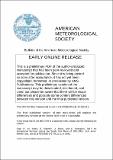| dc.contributor.author | Fogt, Ryan L. | |
| dc.contributor.author | Jones, Megan E. | |
| dc.contributor.author | Solomon, Susan | |
| dc.contributor.author | Jones, Julie M. | |
| dc.contributor.author | Goergens, Chad A. | |
| dc.date.accessioned | 2017-10-31T16:17:40Z | |
| dc.date.available | 2017-10-31T16:17:40Z | |
| dc.date.issued | 2017-10 | |
| dc.date.submitted | 2017-03 | |
| dc.identifier.issn | 0003-0007 | |
| dc.identifier.issn | 1520-0477 | |
| dc.identifier.uri | http://hdl.handle.net/1721.1/112101 | |
| dc.description.abstract | The meteorological conditions during the Amundsen and Scott South Pole expeditions in 1911/12 are examined using a combination of observations collected during the expeditions as well as modern reanalysis and reconstructed pressure datasets. It is found that over much of this austral summer, pressures were exceptionally high (more than two standard deviations above the climatological mean) at both main bases, as well as along the sledging journeys, especially in December 1911. In conjunction with the anomalously high pressures, Amundsen and his crew experienced temperatures that peaked above –16°C on the polar plateau on 6 December 1911, which is extremely warm for this region. While Scott also encountered unusually warm conditions at this time, the above-average temperatures were accompanied by a wet snowstorm that slowed his progress across the Ross Ice Shelf. Although January 1912 was marked with slightly below-average temperatures and pressure, high temperatures and good conditions were observed in early February 1912, when Scott and his companions were at the top of the Beardmore Glacier. When compared to the anomalously cold temperatures experienced by the Scott polar party in late February and March 1912, the temperature change is in the top 3% based on more than 35 years of reanalysis data. Scott and his companions therefore faced an exceptional decrease in temperature when transiting to the Ross Ice Shelf in February and March 1912, which likely made the persistent cold spell they experienced on the Ross Ice Shelf seem even more intense by comparison. | en_US |
| dc.publisher | American Meteorological Society | en_US |
| dc.relation.isversionof | http://dx.doi.org/10.1175/BAMS-D-17-0013.1 | en_US |
| dc.rights | Article is made available in accordance with the publisher's policy and may be subject to US copyright law. Please refer to the publisher's site for terms of use. | en_US |
| dc.source | American Meteorological Society | en_US |
| dc.title | An Exceptional Summer during the South Pole Race of 1911-1912 | en_US |
| dc.type | Article | en_US |
| dc.identifier.citation | Fogt, Ryan L. et al. “An Exceptional Summer During the South Pole Race of 1911-1912.” Bulletin of the American Meteorological Society (March 2017): 2189-2199 © 2017 American Meteorological Society | en_US |
| dc.contributor.department | Massachusetts Institute of Technology. Department of Earth, Atmospheric, and Planetary Sciences | en_US |
| dc.contributor.mitauthor | Solomon, Susan | |
| dc.relation.journal | Bulletin of the American Meteorological Society | en_US |
| dc.eprint.version | Final published version | en_US |
| dc.type.uri | http://purl.org/eprint/type/JournalArticle | en_US |
| eprint.status | http://purl.org/eprint/status/PeerReviewed | en_US |
| dc.date.updated | 2017-10-19T18:28:39Z | |
| dspace.orderedauthors | Fogt, Ryan L.; Jones, Megan E.; Solomon, Susan; Jones, Julie M.; Goergens, Chad A. | en_US |
| dspace.embargo.terms | N | en_US |
| dc.identifier.orcid | https://orcid.org/0000-0002-2020-7581 | |
| mit.license | PUBLISHER_POLICY | en_US |
